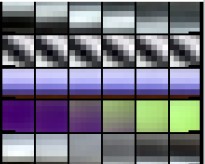Learning kernels for spatio-temporal-chromatic image data
Collaboration with: Mark S. Drew
We look at patches (space-time cubes) of color image sequences and conduct independent (ICA) and principle component analysis (PCA) to obtain different basis functions. While the PCA basis functions optimally represent the data in a least squares sense, ICA basis functions are more suitable for entropy-based variable length encoding. Applied to image compression this advantage became particularly apparent for low bit rates. The work is described in our ICIP 05 paper (bibtex). An extended version has been published at Signal Processing: Image Communication [doi].

The picture shows different kernels with time progressing from left to right. The kernel on top can detect vertically moving edges, below that we find a detector for non-moving diagonal edges, then a horizontal color edge, color transition from blue to green, etc. See our publication for more, higher-resolution examples.
These basis functions have been generated for a set of natural images. While motivated from an image encoding perspective, we point out that using these basis patches for feature detection is very similar in spirit to employing convolutional neural networks that have been pre-trained for a certain class of images (e.g, compare Fig. 3 in AlexNet 2012 with Fig. 4 in our earlier work).